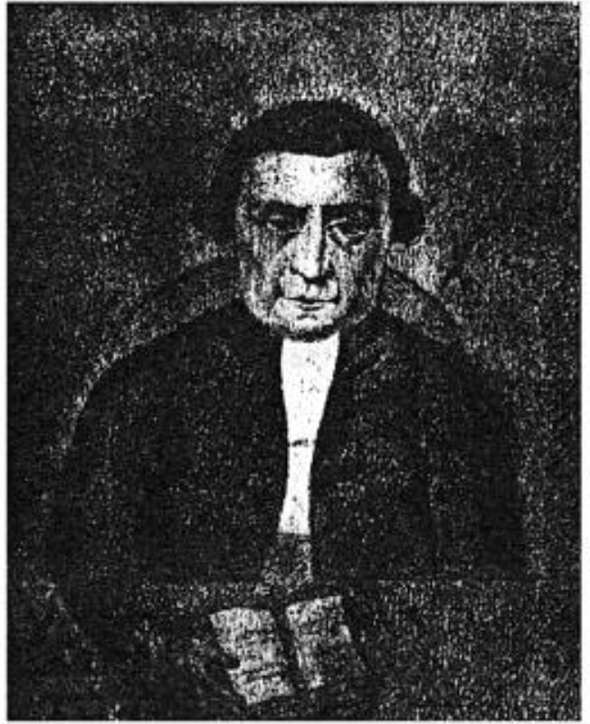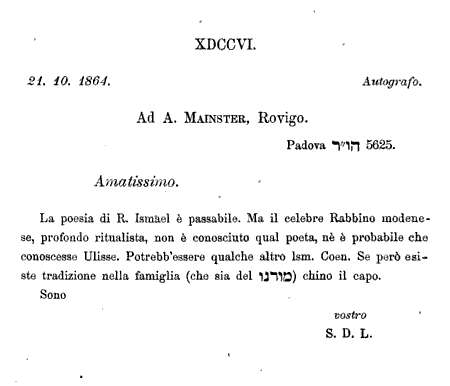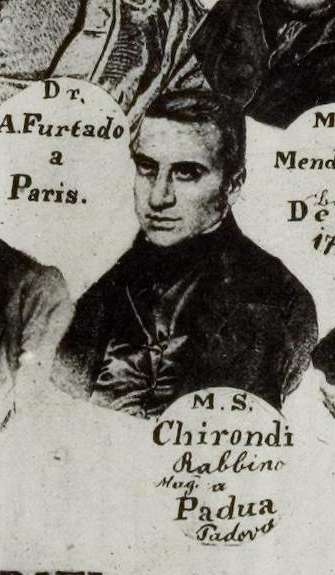I have no doubt that Shimshon, as all great tzaddikim, had a full beard.2This is a surprising assertion.
This is not a merely academic, old debate. Only a year ago Vos iz Neias published an interview with a[n apparently] well regarded Israeli kabbalist named Rabbi Chaim Ezra Fatchia (link). He is not merely a kabbalist, but also a maggid shiur, and mashgiach in a yeshiva. He is clean shaven.
In the comments, the fact that he is beardless was immediately noted. Readers shot back that Ramchal was beardless, and there is/was an Italian kabbalistic tradition going back to R. Menachem Azariah of Fano to be beardless outside of Israel (this is a complex discussion; it became a major issue in the 19th and 20th century; in truth it seems that he wore a beard, but it was neatly trimmed).
As I said, this is a surprising assertion on Rabbi Reisman's part. Fully realizing that he didn't mean to say that really wonderful, kind, generous, pious, righteous individuals without full beards aren't tzadikim, I think he meant "great tzadikim" in the sense that it is commonly used - exceptional, famous saints and sages. Still, it does seem somewhat surprising that he doesn't seem to be aware that most Italian Jews did not wear a beard, and surely this included many tzadikim among them - not only Rabbi Moshe Chaim Luzzatto (where for him the issue seems to be that he was criticized for not growing his beard because he was - or claimed to be - a Kabbalist).
The beardlessness of the Italians was well known, and for the most part accepted. Still it should not surprise anyone that this wasn't always the case. There were many Italian merchants living abroad in various Mediterranean cities. They were known by the native Jews as Francos. As it happens, European travelers in the Middle East and Muslim countries tended to grow their beard because in those countries beardlessness was perceived as very shameful. Still, as Europeans they didn't necessarily want to wear full beards, so unless they were trying to blend in as natives they would wear a trimmed beard. Apparently this achieved the effect they were going for. On the one hand they didn't appear feminine and shameful, but they could still appear European. In all likelihood these Francos also wore trimmed beards, rather than closely trimmed to the skin with scissors, or removal by depilatory cream.
With this background in mind, on at least one occasion, apparently the native Jews of Salonica were scandalized by the closely trimmed beards of the Francos who lived among them. They demanded that they grow them or be expelled. The situation of the ex-pat Italians came to the attention of the Italian rabbis, including one of the foremost ones, Rabbi Samson Morpurgo -
Here is what he looked like:









1 In my opinion this book is, in certain ways, a ground-breaking and important book.
2 Interested readers will want to know that context of this line. Rabbi Reisman begins by noting that many older Bibles show woodcuts of Samson with long hair, but clean-shaven. This seems ridiculous, since he was a Nazir. (And, "all great tzaddikim" have full beards.) However, Rabbi Reisman highlights a Teshuvas Ha-rashba (1:407) in which the Rashba opines that the Nazirite prohibition of cutting hair only applies to the head, but not the beard. Regarding the beard, his prohibition is no more and no less than everyone else's.

- and he replied (שמש צדקה YD #61 pg. 102 [Venice 1743]). He calls the Francos אנשי איטליאה של יון, Italian Jews in Greece, who are being compelled by the חכמי שאלוניקי, the Salonican rabbis, to grow their beards. The question was, what happens if the rabbis carry out their threat? That is, these men will have been excommunicated, so would it be valid? He begins by saying that he will not personally address the specifics of this case, as he does not want to multiply machlokes, disharmony. However, he will address the general rabbinic audience and also the issue of rabbinic authority, and whether in this day and age any bet din has the right to compel stringencies and special pious behaviors. He discusses many laws which are no longer practices, yet the rabbis in their wisdom don't try to force people to obey, which would then result in their sinning out of rebellion. An example he gives is wearing tzitzis altogether, or to have them showing outside. He then points out that we have a reliable tradition that the term "destruction" in the verse about beard-removal refers to a single blade razor. Anyone who says otherwise is arguing on the truth and it is almost as if he is saying אין תורה מן השמים! He then deals with possible objections one may raise from the the language of the Tur, which the Beit Yosef clarifies. He also deals with a Terumas ha-Deshen (#295) which seems to say that there is a hint of sin with removing it with scissors, and therefore one should be strict. Morpurgo notes that we see from the Terumas ha-Deshen's own words at the end of the responsum what he meant to say; he writes that using scissors which are too sharp is problematic, since then there is a concern that only one blade is removing the beard, and that is prohibited. Thus he meant to say that removing it with especially sharp scissors is almost sinful, therefore it is a reasonable chumra, to be strict. He then discusses two other halachic sources, which while opposed to removing the beard, consider it a measure of piety, not law.
He gets into a lengthy discussion about piety and Kabbalah, and ultimately he hopes that the rabbis of Salonica will chill.
Not surprisingly this wasn't the only possible response to the situation, even from other Italian rabbis. Rabbi Joseph Ergas, who was one of those who had question Ramchal's lack of a beard, had reached a different conclusion - not because he was a fanatic, but because he is sympathetic to the rabbis there who desired that all residents of the city follow local custom - בין בקולות בין בחמורות - both stringencies and leniencies. Unfortunately I don't know for sure if he himself had a beard, although he must have, as a Kabbalist and, as I said, was critical of Luzzatto on this point. His responsum is quite interesting for its analysis of residency and local minhag.
Some other pictures of Italian rabbis. Below is Haham Raphael Meldola, who was rabbi of the Sephardic Jews of London. A native of Leghorn, he was ordained by the Chida (on him see here):

Here is the rabbi with the best name of any who ever lived - Rabbi Yishmael Kohen of Modena (1730-1811) who was also known by the name Laudadio Sacerdoti, which is a direct translation of "Yishmael Kohen" into Italian.

In fairness, I can't tell if he is clean-shaven or has a very closely trimmed, small beard. But he sure does have a wig on, and that is his kippah too. He was the author of excellent responsa called זרע אמת, which are cited numerous times by Rabbi Moshe Feinstein in Iggeros Moshe and many other posekim. In fact, a search of it turns up many hundreds of results besides for responsa of R. Ovadya Yosef. Although I can't say that the average yeshiva bochur looks at זרע אמת too often, I've seen that they are a normal part of the otzar (library) of many, many yeshivos. I imagine many people would be surprised if they saw what he looked like. I don't know if he was a "great tzaddik," but I'm sure he was pretty good, or at least better than average.
Interestingly enough, when Wessely wrote Divre Shalom ve-Emes, and rattled the Europe rabbinate in 1782 with his advocacy of educational reform3 he appealed to the Italian rabbis for support. Since he had mostly only been saying that Western European Jews should do what the Italian Jews had done for generations, he assumed they would support him, and he mostly assumed right. While they took pains to point out where they did not agree entirely with him, and some rabbis did so only grudgingly, they could not oppose things like a graded curriculum or secular education. Presumably they were proud of their traditional Jewish culture, and they indeed wrote words in support.
However, one of the Italian rabbis who did not support Wessely was Rabbi Laudadio Sacerdoti. His view is printed in responsum #107 in volume 2. He was concerned that Wessely's plan in effect turned the order of priorities upside down - Torah secondary, but humanistic education primary. However, he too agreed that a graded curriculum was only proper and that it is necessary to know languages. Lois Dubin pointed out that his own poetic compositions included references to mythological figures like Ulysses, which Shadal, who refers to his status as a posek by noting that he was "profondo ritualista," frankly found surprising.

Next we have the author-collaborator of a well-respected, often quoted sefer called Toldos Gedolei Yisrael by Rabbi Mordechai Marco Ghirondi, av beis din of Padua (1799-1852).

Obviously somewhat modern, yet in Rebbetzin Bruriah Hutner-David's haskalathon phd thesis, she grudgingly concludes that he was "squarely on the side of traditionalism," noting for example that in one letter he chides a correspondent for reading Karaite literature.
Interestingly, the tide in Italy appeared to have changed mid-19th century - probably on fashion grounds. Here is the young son of Shadal, Ohev Ger Luzzatto:

Of course I have to acknowledge an article which made a big impact on me - Elliot Horowitz's The Early Eighteenth Century Confronts the Beard: Kabbalah and Jewish Self-Fashioning (Jewish History 8.1-2 1994) which I read I don't know how many years ago, and in some ways was a revelation of an article for me - where some of these things are discussed in much greater detail.
And for the record, here is the much-discussed portrait of R. Menachem Azariah of Fano, who was also known as Immanuel - oddly enough, because this great Kabbalist's secular name was Manuel. Working backward, this gave him a Hebrew nickname. To the Chida this was something everyone knew - וידוע דהרמ"ע קרו ליה הרב עמנואל לפי שמנחם בלשון גוים קורין לו מנואל. Evidently it is for this reason that he sometimes signed his name מנחם עזריה עמנואל. A contemporary, Rabbi Shabbetai Sofer refers to him this way:

Which in plain Hebrew reads הגאון המקובל האלהי החסיד מהר"ר מנחם עזרי' הנקרא עמנואל. This is at the end of the third section of the general introduction to his siddur. Yes, the manuscript is online, although not very useful. Incidentally this little passage refers to a teshuva of the Maharam of Lublin, which his family censored from publication because he retracts a position in the face of Rabbi Shabbetai's arguments.

Also see this post about the rabbi depicted below's stringent stance against shaving on chol ha-moed:

2 Interested readers will want to know that context of this line. Rabbi Reisman begins by noting that many older Bibles show woodcuts of Samson with long hair, but clean-shaven. This seems ridiculous, since he was a Nazir. (And, "all great tzaddikim" have full beards.) However, Rabbi Reisman highlights a Teshuvas Ha-rashba (1:407) in which the Rashba opines that the Nazirite prohibition of cutting hair only applies to the head, but not the beard. Regarding the beard, his prohibition is no more and no less than everyone else's.
3 Reading a headline in the Matzav.com blog yesterday made me smile: Agudath Israel of New Jersey Applauds Governor Christie for His Stance on Educational Reform. No, he is not opposed to educational reform. Apparently "educational reform" is okay sometimes.
